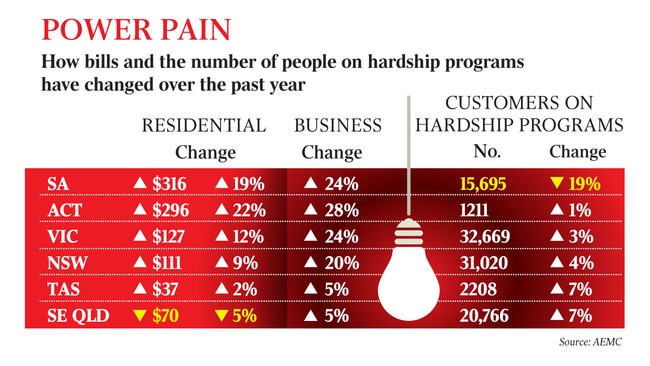Confidence in energy retailers falls as prices rise
Confidence in energy retailers has sunk to crisis levels with customers saying the prices are worse value than other sectors.

Confidence in Australia’s electricity market has sunk to crisis levels with customers saying the prices offered by energy retailers provide worse value for money than services in the banking, mobile phone, internet and insurance sectors.
In its fifth review of retail competition, the national energy market’s key rule-making body has delivered a damning analysis of consumer sentiment. It reveals that only a quarter of customers believe the market is working in their long-term interest.
Only one in two have confidence in the information available to make good decisions, while just 39 per cent of consumers have trust in the energy sector — down from 50 per cent in 2017.
The Australian Energy Market Commission review found that a failure by retailers to make their offers easier to understand had driven government intervention and that rising concern over power price rises had achieved little change.
The negative report card comes despite concerted efforts by government to drive down prices. Prime Minister Malcolm Turnbull last year forced the big three retailers — AGL, Energy Australia and Origin Energy — to provide clearer pricing information to consumers.
The Turnbull government also introduced rule changes aimed at providing certainty around power discounts and it intensified efforts to promote its power bill comparison website, Energy Made Easy.
The AEMC will make six recommendations today to the Council of Australian Governments’ Energy Council — chaired by federal Energy Minister Josh Frydenberg — proposing changes to improve information for customers seeking to escape high prices.
These include a new code of conduct to govern energy comparison sites. The AEMC warns the sites contribute to industry costs without always helping customers find the best deal. It says some sites lack transparency about the range of offers and the fees and commissions paid by retailers.
The AEMC also says it is consulting on rules to enable consumers to read their own meters to improve accuracy and reduce bill shock, and set minimum time frames for new smart meters to be installed. It is also considering how hardship provisions could be improved to protect the most vulnerable consumers.
The review suggests the Australian Energy Regulator separately report on customer numbers, switching rates and contract types for residential and small business consumers. However, the 351-page review finds that savings are available to customers prepared to switch retailers. AEMC chair John Pierce notes that consumers who stay faithful risk being hit with a “loyalty tax”.
The report shows a residential customer moving from a median standing offer to the cheapest market offer can save $832 a year on electricity in South Australia, $574 in Victoria, $504 in southeast Queensland, $365 in NSW, and $273 in the ACT. The number of consumers switching retailers was up in all jurisdictions — Victoria recording the highest increase for electricity and gas and at least a quarter of customers in southeast Queensland changing.
The report noted that, after being with one of the big three retailers for three to four years, the proportion of customers receiving “higher” level discounts tended to stabilise at about 20 to 40 per cent.
An alarm was also sounded on aggressive retailer behaviour. The AEMC found confusion around complex public offers allowed some retailers to engage in price discrimination based on how well informed customers were.
Writing in The Australian today, Mr Pierce implores retailers to move away from their “current approach of simply passing through network price changes”. While falling wholesale prices were being passed on, Mr Pierce says this is “just the beginning of what retailers need to do”.
“Now is the golden opportunity for retailers to start rebuilding trust and confidence … They can do this by making it simpler and easier for consumers to understand the deals on offer,” Mr Pierce said.
“Consumers are telling us they have had enough of nine-block tariffs made up of peak/off-peak/shoulder rates for three seasons — just unnecessarily confusing.”
From AEMC data, the government has concluded the big three have a “significant number of households on market offers with a zero discount”.
The AEMC review noted that power prices for residential consumers had increased across all regions — from $111 in NSW to $316 in South Australia — except southeast Queensland, where bills fell by $70. Electricity costs for small businesses went up across all jurisdictions — from 5 per cent in Queensland to 28 per cent in the nation’s capital.
Solar installations in 2017 rose 154,877 or 25 per cent on 2016. There are now 1.8 million Australian households featuring solar panels. Battery installations increased about 275 per cent.


